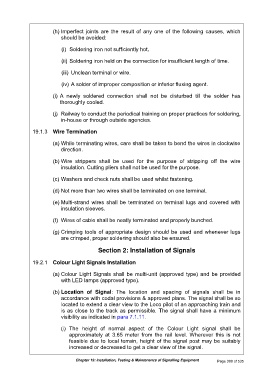Page 440 - IRSEM_Main Book
P. 440
(h) Imperfect joints are the result of any one of the following causes, which
should be avoided:
(i) Soldering iron not sufficiently hot.
(ii) Soldering iron held on the connection for insufficient length of time.
(iii) Unclean terminal or wire.
(iv) A solder of improper composition or inferior fluxing agent.
(i) A newly soldered connection shall not be disturbed till the solder has
thoroughly cooled.
(j) Railway to conduct the periodical training on proper practices for soldering,
in-house or through outside agencies.
19.1.3 Wire Termination
(a) While terminating wires, care shall be taken to bend the wires in clockwise
direction.
(b) Wire strippers shall be used for the purpose of stripping off the wire
insulation. Cutting pliers shall not be used for the purpose.
(c) Washers and check nuts shall be used whilst fastening.
(d) Not more than two wires shall be terminated on one terminal.
(e) Multi-strand wires shall be terminated on terminal lugs and covered with
insulation sleeves.
(f) Wires of cable shall be neatly terminated and properly bunched.
(g) Crimping tools of appropriate design should be used and whenever lugs
are crimped, proper soldering should also be ensured.
Section 2: Installation of Signals
19.2.1 Colour Light Signals Installation
(a) Colour Light Signals shall be multi-unit (approved type) and be provided
with LED lamps (approved type).
(b) Location of Signal: The location and spacing of signals shall be in
accordance with codal provisions & approved plans. The signal shall be so
located to extend a clear view to the Loco pilot of an approaching train and
is as close to the track as permissible. The signal shall have a minimum
visibility as indicated in para 7.1.11.
(i) The height of normal aspect of the Colour Light signal shall be
approximately at 3.65 meter from the rail level. Wherever this is not
feasible due to local terrain, height of the signal post may be suitably
increased or decreased to get a clear view of the signal.
Chapter 19: Installation, Testing & Maintenance of Signalling Equipment Page 388 of 535

